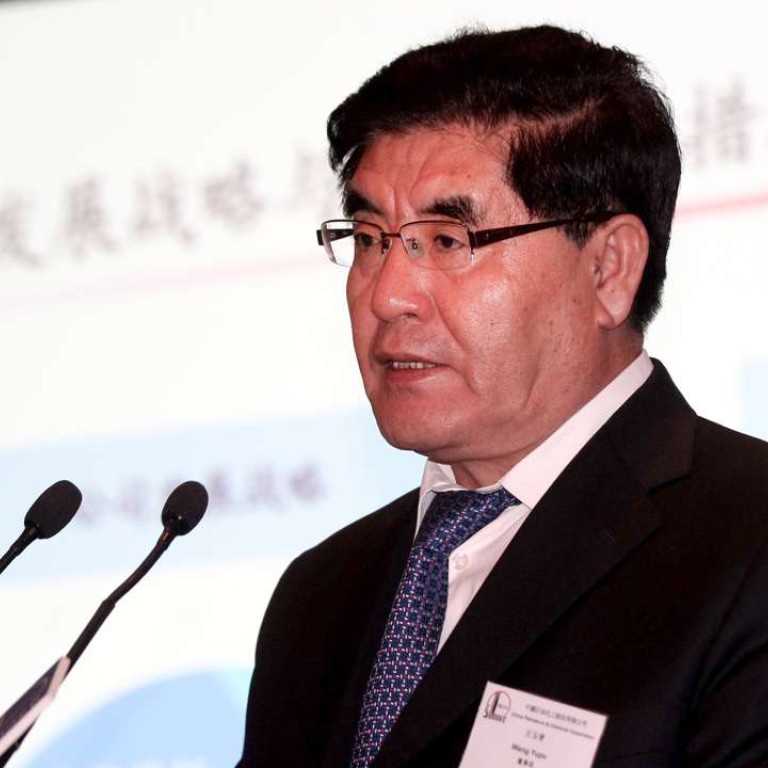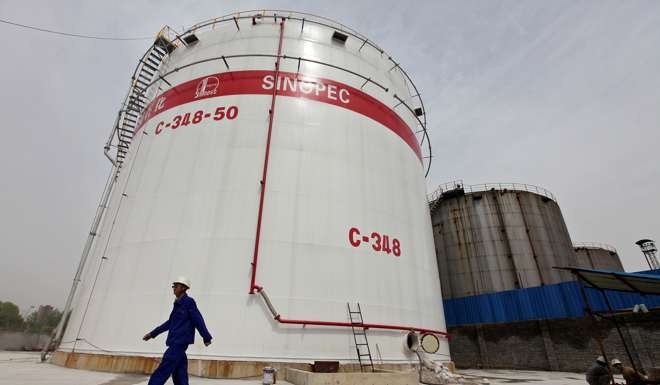
Chinese oil major Sinopec slashes both oil and gas output targets
China Petroleum & Chemical (Sinopec) has joined its larger domestic rival PetroChina in slashing this year’s oil output targets as production costs at some of its mature and high cost fields are not viable amid expectations that oil prices will remain low for a while longer due to oversupply.
Sinopec has cut its crude oil output target by 9.3 per cent to 301.2 million barrels this year from the 332 million barrels goal announced in March. PetroChina has cut its target by 3 per cent.
“We have proactively adjusted the production of certain oilfields that are unprofitable so as to cut losses,” chairman Wang Yupu told reporters. “But if oil prices rebound, we will resume their production.”
Sinopec has based its production plan on an oil price assumption of US$45 to US$50 a barrel for the second-half of the year, the same as PetroChina.
But unlike PetroChina, Sinopec – the nation’s third largest oil and gas producer and the world’s second largest oil refiner – has also cut its natural gas production because high regulated prices meant demand fell short of expectation.
“While plant maintenance at our Puguang gas production facilities [in Sichuan province] is a factor, the main reason is a lack of demand due to high gas prices,” vice chairman Dai Houliang told the Post after a press conference on Monday. “There is no problem with our production capacity.”
We have proactively adjusted the production of certain oilfields that are unprofitable so as to cut losses
Although Beijing slashed the regulated non-residential wholesale gas price by 28 per cent last November, prices of the cleaner burning fossil fuel remained higher than crude oil derived replacement fuel such asliquefied petroleum gas, diesel and gasoline, whose prices fell in tandem with international crude prices.
Second-half production plan data unveiled by Sinopec on Sunday showed that it has reduced its full-year gas output target by 6.4 per cent to 809.9 billion cubic feet from 865 billion cubic feet as announced in March.
It unveiled the plan as it reported a milder than expected 21.6 per cent year-on-year first-half net profit fall due to higher than expected oil inventory value gains.
First-half gas output grew 10 per cent year on year, trailing the full-year 17 per cent growth target. This followed realised production growth of only 2.6 per cent last year, far less than its original aggressive growth target of 23.7 per cent, also due to demand shortfall due to the price uncompetitiveness of gas against oil despite the environmental advantage of gas.
Analysts noted that Beijing has been in a dilemma on regulating gas prices, which have been partially deregulated.

“As such, the midstream pipeline segment has become the sacrificial lamb in efforts to lower gas prices.”
Beijing earlier this month released an industry consultation paper, proposing to cap gas pipeline transmission return rates at 8 per cent, much lower than current rates.
Sinopec chairman Wang Yupu would not be drawn to comment on the proposal, saying the company is still studying it. But he said the firm has attracted “a long list” of interested potential investors in buying a 50 per cent stake in its gas pipeline linking Sichuan province and Shanghai, adding that many are firms controlled by governments of cities along the gas pipeline.
It has not decided on the timetable and method of disposal of the stake, which analyst Beveridge estimated to be worth 14.7 billion yuan, assuming it can be sold at a 50 per cent premium to its book value, from which Sinopec could generate a gain of 5 billion yuan in the year’s second half.
Dai said the proceeds would fund future capacity expansion of the pipeline.
Wang said Sinopec is targeting to almost double gas output to 40 billion cubic meters in the five years to 2020, or an average annual growth of 14 per cent.
The strategy to grow gas output more than oil output is similar to that adopted by PetroChina, which aimed for gas to account for half its total oil and gas output by 2020, up from 37 per cent currently.
Sinopec shares edged down 0.2 per cent on Monday to HK$5.61, compared to a 0.4 per cent fall in the Hang Seng Index. They have surged 19.9 per cent year to date, outperforming the index’s 4.1 per cent gain.

